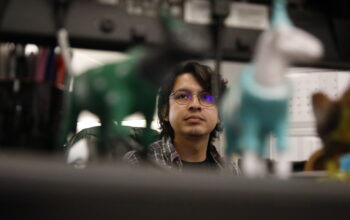For most classes, 38 students would make plenty of noise.
The group outside the Village classroom at Pierce College is extremely quiet—but their hands and arms are moving rapidly and most are making eye-to-eye contact with each other.
The professor arrives, unlocks the door, and the students file in and take their seats.
American Sign Language 1 (ASL) is ready to begin.
Professor Cindy Herbst has taught for 34 years at Pierce College and is the ASL instructor.
“ASL is a two-year Associate in Arts degree program in American Sign Language and English interpreting,” Herbst said.
“Employment opportunities in sign language interpretation is the goal, from educational to community based settings, like medical, appointments with lawyers, doctors, mechanics; all things people do everyday of their life.”
Professor Herbst was a hearing child who grew up with deaf parents.
Growing up she knew they were different from other families, but she spent a lot of time around other hearing family members, therefore she learned how to verbally communicate and sign at a young age.
Starting at five years old, she would translate for her parents.
“I saw the original play, ‘Children of a Lesser God,’ at the Ahmanson Theater.
It was a significant depiction of the deaf experience that was offered to the grand population, on a larger scale than what typically happened before.
It was such a successful production on such a grand level like that.
So that was the beginning of people’s awareness of a different way of living life,” Herbst said.
Miguel Rodriguez, a student at Pierce College, “is very well known by many of the students in the ASL program” according to Herbst.
He is majoring in mathematics and hopes to become a math teacher.
He was not born deaf but lost his hearing at 3 months from an illness.
Rodriquez’ parents decided to put him in oral school so he would be able to communicate with them.
In school he understood pictures and concepts of what the teacher was teaching, but was unable to speak.
The teacher decided it was best he go to a school where he would learn how to sign.
His family also tried to learn how to sign in order to communicate with him.
When they did not understand each other they would draw pictures to communicate until he was able to write.
“I attended a deaf elementary school where I felt comfortable and at home,” Rodriguez signed.
His whole world changed when he had to attend a non-deaf middle school.
“I felt out of my element, but not as much as when I attended high school. In middle school, my parents would translate for me and keep me under their wing, but in high school I was on my own and had to learn how to interact with the hearing,” he signed
A student who benefits from the program is Lane Green, 21, interpreting major.
Green wants to use his interpreting skills to help children.
Green is in ASL 3. He has been signing for almost 5 years.
“Several of my family members have Aspergers syndrome or are deaf.” Green said. “I love the method of communication. It is a very straightforward method of language.”



